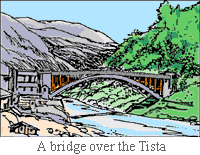
Dimdima
Online Children's Magazine from India

Dimdima
Online Children's Magazine from India
Sikkim became a protectorate of India in 1950 and a state in 1975.
Area : 7,096 sq kms.
Population : 5,40,493. The Lepchas, Bhutias and the Sherpas are the major ethnic groups inhabiting the state.
Language : The local language is Nepali, while English is the official language.
Capital : Gangtok
Location :
Sikkim, India's second smallest state, is located in the northeastern part of the country. Nepal borders it in the west and Bhutan in the east, China lies to the north and northeast, and West Bengal to the south. Because of its location, it has a political and strategic importance.
Physiography :
Sikkim is surrounded on three sides by steep mountain walls. Kanchenjunga, India's highest peak and the world's third highest mountain is in Sikkim. The locals have traditionally viewed the mountain as both a god and the abode of gods.
A number of glaciers descend from Kanchenjunga into Sikkim. The river Teesta is formed from one such glacier.
Economy :
The economy of Sikkim is based on agriculture and animal husbandry. Maize, rice, wheat and barley are produced in terraced fields in the valleys. Beans, ginger, potatoes, vegetables, fruits and tea are also grown. Sikkim is one of the world's main producers of cardamom. About one-third of Sikkim is forested. It also has a rich and varied animal life, including the black bear, panda, numerous species of deer, and the Tibetan antelope.
Copper, lead, zinc, coal, graphite, and limestone are among the minerals found in the state, though not all are commercially exploited.
Until the early 1970s, Sikkim had only cottage industries, producing handwoven textiles, carpets, and blankets—as well as traditional handicrafts. Now there are a number of small-scale industries.
Transport :
Roads, though not extensive, are the primary mode of travel. Ropeways have also been provided at many points.
The kingdom of Sikkim was established in 1642, and the Dalai Lama recognized Phuntsog Namgyal, as the first chogyal (temporal and spiritual king). The Namgyal dynasty was to rule Sikkim till 1975.
Beginning in the mid-18th century, Sikkim fought a series of territorial wars with Bhutan, as its king opposed the accession of a minor king in Sikkim. Nepal too, came to occupy parts of western Sikkim and part of the Terai region. This period also saw the largest migration of Nepalese to Sikkim.
The British interest in Sikkim manifested itself in the early 19th century as they wished to gain an access to Tibet. In return for its support to the British in the Anglo-Nepalese war of 1814-16, Sikkim regained the Nepalese-occupied territories. By 1817, Sikkim had become a de facto protectorate of Britain, though there was resentment by the Sikkimese to British interference in their affairs and to the construction of highways through their territory.
The British East India Company obtained Darjeeling from Sikkim in 1835. Incidents between the British and Sikkimese led to the final annexation in 1849 of the Terai region. The subsequent military defeat of Sikkim, ended in the Anglo-Sikkimese Treaty of 1861, which established Sikkim as a princely state under British paramountcy. The British were given rights of free trade and to build roads through Sikkim to Tibet.
In 1950, after India's independence, a treaty was signed between Sikkim and India making Sikkim an Indian protectorate, with the centre assuming responsibility for Sikkim's external relations, defence, and strategic communications.
After 1947 Sikkim's political parties raised demands for the establishment of a democratically elected government, and accession of Sikkim to India which was resisted by the chogyal and his supporters. In 1974, the newly-elected Sikkim Congress launched a campaign to obtain greater political liberties and rights. The chogyal attempted to suppress the campaign. When violence escalated, the chogyal asked the Indian government to intervene. In a special referendum in 1975, more than 97 % of the electorate voted for the merger of Sikkim with India and Sikkim became the 22nd state of the Indian Union on May 15, 1975.
Sikkim, on its western boundary, is dominated by Kanchenjunga (8,598 m), the third highest mountain in the world. The awesome peak overlooks a land dotted by monasteries and which is famous for its orchids and vast forests of rhododendrons.
Though monasteries like the Rumtek, (the centre of the Kagyu-pa sect), the Pemayangstse Monastery and the centuries-old Tashiding Ningma Monastery are major tourist
attractions, some tourists are drawn by adventure sports like river rafting and kayaking on the Tista. The Tista and the Rangit are the major rivers of Sikkim. While the Tista runs down fairly straight from the Himalayas and then across beautiful valleys and deep forests to the plains of West Bengal, the Rangit twists and turns. However they run parallel for some distance and finally meet and flow into the plains together. The confluence of the two rivers is a holy place for Lepchas. The Lepchas were the first settlers of Sikkim. They were followed by the Bhutias and others in the 14th century. The Nepalese came last but today they form the majority community.
Most of the people of this second-smallest state of India (Goa being the smallest) are farmers.
The capital and chief city is Gangtok which means "hill top", an appropriate name for a town perched at a height of 1,520 metres.



Dimdima is the Sanskrit word for ‘drumbeat’. In olden days, victory in battle was heralded by the beat of drums or any important news to be conveyed to the people used to be accompanied with drumbeats.
Bharatiya Vidya Bhavan
K. M Munshi Marg,
Chowpatty, Mumbai - 400 007
email : editor@dimdima.com
Bharatiya Vidya Bhavan
505, Sane Guruji Marg,
Tardeo, Mumbai - 400 034
email : promo@dimdima.com
Dimdima.com, the Children's Website of Bharatiya Vidya Bhavan launched in 2000 and came out with a Printed version of Dimdima Magazine in 2004. At present the Printed Version have more than 35,000 subscribers from India and Abroad.